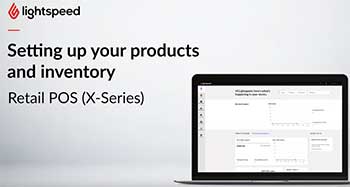When it comes to choosing a point of sale (POS) system for your retail business, two of the top options to consider are Lightspeed’s R and X series. Both provide powerful POS capabilities, inventory management, detailed analytics and reporting, and integrations with other business systems. However, there are some key differences between the two that are important to understand before making a decision.
In this detailed comparison guide, we will examine the key features, pros and cons, pricing, and ideal usage scenarios for Lightspeed’s R and X series systems. Whether you’re opening your first brick and mortar store or looking to upgrade your existing POS, this guide will provide the information you need to select the right Lightspeed product for your business needs and budget.
Brief Comparison Table
| Feature | Lightspeed R Series | Lightspeed X Series |
| Ideal for | Smaller retailers with simpler needs | Larger retailers with advanced needs |
| User interface | Simpler, modular | Advanced, customizable workflows |
| Hardware | Standalone terminals | Robust all-in-one terminals |
| Payments | Built-in payments acceptance | Advanced payments and multi-store management |
| Analytics and reporting | Basic sales and inventory reporting | Robust advanced analytics and custom reporting |
| Add-ons and apps | Limited availability | Extensive app and integration ecosystem |
| Pricing | Lower monthly fees | Higher monthly fees, more pricing tiers |
Overview Of Lightspeed R Series POS
The Lightspeed R series is the starter tier POS system from Lightspeed, ideal for smaller retailers with simpler needs. Some key features of the R series include:

- Streamlined POS interface optimized for quick transactions
- Built-in payments acceptance via Lightspeed Payments
- Basic inventory management and purchasing workflows
- Customer database and loyalty program management
- Access to Lightspeed’s mobile apps for sales associates
- Simple sales, inventory, and employee reporting
- Single store management (multi-store add-on available)
The R series uses an intuitive, modular interface that lets you easily add and arrange menu buttons and features as needed. It can be used with Lightspeed’s own POS hardware bundles or integrated with third-party peripherals. Standard onboarding, setup, and 24/7 customer support are included.
Ideal for: Independent retailers, quick-service restaurants, boutiques, and other small businesses with simpler POS needs.
Pros: Affordable monthly fees, easy to learn and use, seamless Lightspeed Payments integration.
Cons: Limited choice of hardware bundles, less advanced features and customization.
Overview Of Lightspeed X Series POS
The Lightspeed X series is the advanced tier POS system from Lightspeed, packed with features for more complex retail and restaurant environments. Key capabilities include:

- Highly flexible interface with customizable menus and workflows
- Broader hardware support including full-featured all-in-one terminals
- Advanced multi-store management and data syncing
- Integrated payments with lower credit card rates
- Robust inventory control with purchase orders and transfers
- Powerful analytics on sales, products, customers and more
- Automations for discounts, promotions, and loyalty programs
- Extensive app and integration ecosystem
- Optional guest manager, online ordering, and accounting add-ons
The X series prioritizes advanced capabilities over simplicity. The interface is highly customizable using Lightspeed’s Blueprint tool. X series bundles also include Lightspeed’s smart terminals with integrated payments, receipt printers, bar code scanners, and other peripherals.
Ideal for: Multi-location retailers, restaurants, grocery stores, and other larger businesses.
Pros: Enterprise-grade features, custom workflows, robust hardware bundles, strong analytics and reporting.
Cons: Higher monthly fees, steeper learning curve for setup and use.
Detailed Feature Comparison
Now that we’ve provided an overview of Lightspeed’s R and X series POS systems, let’s take a deeper dive into their features and capabilities across some key categories:
User Interface And Ease Of Use
The R series interface uses a simpler modular design that’s quick and easy to navigate for making sales and transactions. The X series has a highly customizable interface powered by Lightspeed’s Blueprint tool. It provides more advanced workflows, but takes more time to set up and learn.
The R series is better suited for businesses where simplicity and fast POS transactions are bigger priorities. The extensive customization of the X series is preferable for larger businesses with complex order/service flows.
Hardware And Equipment
The R series is designed to work seamlessly with Lightspeed’s own POS hardware bundles containing terminals, cash drawers, printers, and scanners. It offers less flexibility for integrating with third-party peripherals.
The X series offers greater hardware flexibility, including support for Lightspeed’s high-end smart terminals. These Android-based terminals have integrated touchscreen monitors, payments, printers, and scanners in a single device.
If an all-in-one robust POS terminal is important for your business, the X series hardware is a better choice. The R series bundles still provide capable hardware that should meet the needs of many smaller retailers.
Payments, Integrations, And Apps
Both the R and X series come with built-in payments powered by Lightspeed Payments, providing simplified credit card processing with no extra hardware needed.
However, the X series provides advanced payments capabilities including: lower credit card rates for high volume businesses, support for newer payment technologies like contactless and mobile wallets, and multi-store management of payments data.
The X series also offers an extensive app and integration ecosystem allowing you to connect the POS with accounting software, ecommerce platforms, loyalty programs, and more. The R series has a more limited set of add-ons available.
If you need deep accounting or ecommerce integrations, prefer lower card processing fees, or want newer payment options, the X series is the better choice. But the R series still provides a solid payments foundation.
Management, Analytics, And Reporting
When it comes to store management tools and business insights, the X series include a more robust set of features focused on supporting multi-location businesses.
The R series still provides core sales, inventory, and employee reporting. But the X series expands on these with dashboards for things like seasonal demand forecasting, customizable reports, customer purchase history, and detailed sales analysis. These provide enterprise-level insights into product, department, and channel performance.
For single location retailers that just need basic reporting, the R series capabilities will suffice. Multi-store businesses will benefit more from the advanced analytics in the X series.
Pricing And Contracts
Lightspeed’s R series starts at $69 per month but can cost more depending on hardware bundles, additional registers, and add-ons.
The X series pricing starts at $149 per month for core features, but goes up to $299 per month for the highest tier plan designed for complex multi-location environments.
Businesses should carefully evaluate their feature needs and projected monthly transaction volumes when selecting a plan. The R series offers simpler needs a more affordable POS system while the X series provides greater capabilities and customization for larger retailers that justify a higher price tag.
Also Read: Is Revel Better Than Lightspeed?
Support And Training
Both the R and X series come with Lightspeed’s standard setup services like installation, employee training, and onboarding. The R series interface is easier for employees to learn while the highly customizable X series takes more upfront training.
Lightspeed also provides 24/7 customer support and ongoing access to support materials and training resources for both tiers. However, larger X series customers may benefit from premium support options.
Overall, small retailers with no prior POS experience may find the R series’ simpler interface and setup process easier to adopt. But the X series offers greater customization to match unique business needs, albeit with a steeper learning curve.
Ideal Usage Scenarios
To summarize the key differences in ideal usage:
- The R series is designed for independent small businesses like boutiques, salons, cafes, and quick-service restaurants. It provides an affordable and approachable POS solution for first-time POS users.
- The X series serves larger multi-location retailers, restaurants, and franchises that need advanced capabilities like centralized management, custom workflows, robust reporting, and complex integrations. It’s built to scale.
Businesses should consider their current size, growth goals, and operational complexity when deciding between the two tiers. Other factors like average transaction size, payment needs, and hardware requirements will also impact the decision.
While the X series unlocks Lightspeed’s full suite of enterprise-grade features, many independent retailers find the R series provides all the essential POS functionality they actually need while keeping costs low.
FAQs
Lightspeed X is the advanced tier POS system from Lightspeed designed for larger, complex retailers. It provides highly customizable workflows, robust all-in-one hardware options, advanced payments processing and analytics, and an app ecosystem for integrations.
No, Lightspeed and Vend are competitors in the retail POS software space. Lightspeed offers both R and X series systems while Vend sells just one POS product. Key differences include Lightspeed having more advanced hardware bundles, lower payment processing fees, and stronger multi-store capabilities.
Both offer POS systems but Lightspeed is designed specifically for retail and restaurants whereas Square serves a broader range of business types. Lightspeed has features tailored to retail like advanced inventory, purchasing, and reporting. Square places more emphasis on general SMB services beyond just POS capabilities.
Lightspeed is one of the top rated and most widely used POS systems for retail and restaurants. Key benefits include integrated payments, flexible hardware options, multi-store capabilities, and advanced analytics. Lightspeed also provides tailored solutions for specific industries. The choice between R and X series comes down to business size and complexity of needs.
Conclusion
When evaluating Lightspeed’s R Vs. X POS system lines, businesses must consider factors like current operations, growth objectives, hardware needs, and budget. Although the X series unlocks Lightspeed’s full suite of enterprise-level features, the more affordable R series still provides a solid POS foundation for many independent retailers.
Carefully determining which tier aligns with your business goals and functionality requirements will lead you to the right Lightspeed solution.